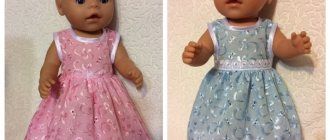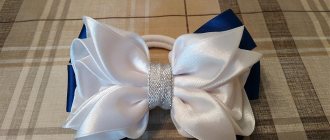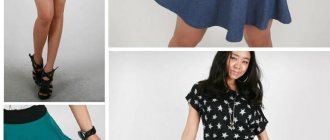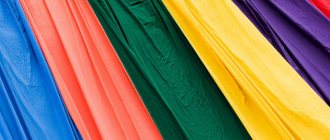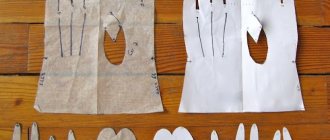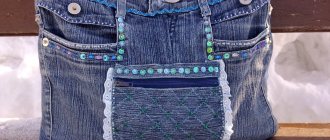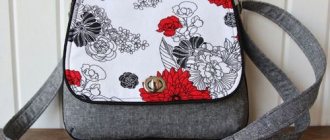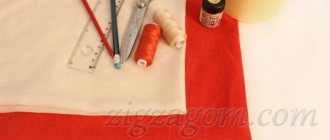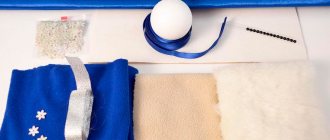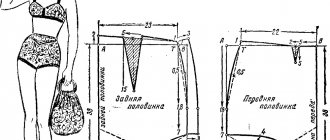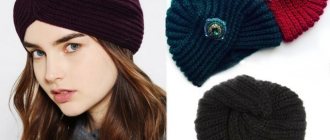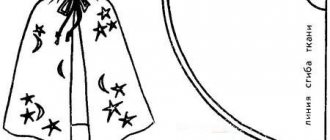During the cold season, clothing for the Yorkshire Terrier must be present so that the dog feels warm and comfortable in it.
Despite the fact that the breed originated from the northern part of Europe, namely from England, where the average air temperature in January-February is 4-5° below zero, it is decorative. The pet spends most of its life at home and is not used to being in the cold. Having a dog outside during the rainy and snowy season becomes stressful for your Yorkie.
What you need
To successfully sew, it is enough to have minimal skills; school labor lessons will suffice. A lot of patterns for all styles and needs: from underpants (for girls during heat) to a decorative dress (in which you can even go to a fashionable exhibition) will allow you to create with your own hands any ideal image of a Yorkshire terrier.
Knitting
For knitting, it doesn’t matter too much which tool you use. Mostly, warm thick sweaters, hats and jackets are knitted, and hooks are used to make lighter, summer and spring versions of the same dresses. With a little practice, you can even move on to boots and shoes with seals on the soles.
Knitted models are truly rare and you won’t find a quality item at a reasonable price in regular pet stores. By adding a little more creative imagination, it is possible to even try something complex and designer for the holiday.
Yorkies are not ordinary dogs; they have rather long hair that rolls off into ugly, sloppy hairs, causing discomfort to the pet.
So for a Yorkshire terrier, you should not use a clothing pattern for a dog of any breed. As a last resort, you need to mark and sew a small indentation for possible friction.
A nice plus is that absolutely any pattern is the same: both for sewing and for knitting with your own hands. This makes it possible to find a significant amount of clothing online, in addition to those described below.
Wardrobe
Not all of the items listed below must be included in your pet's wardrobe. But among them there are those that the Yorkie cannot do without.
Raincoats
They look attractive thanks to their bright colors, and they also protect Yorkshire Terriers from the rain. The main advantage of a raincoat over overalls is that it looks more stylish and unusual. In addition, overalls made of raincoat fabric cannot always be worn on a hot but rainy summer day. But a raincoat will come in handy.
Jumpsuits
They are demi-season and insulated, designed for winter cold. They do not interfere with the Yorkie's active movement during walks or training and, better than other clothing, protect the dog's fur from precipitation and dirt. If you wish, you can buy or order overalls for your dog.
A Yorkshireman's wardrobe must have at least two overalls: autumn and winter.
Sweaters
They are beautiful and comfortable, and the dog can wear them both indoors and outdoors. Sweaters can be either plain or decorated with intricate patterns. They are comfortable because they do not restrict your pet’s movements and at the same time provide good warmth. True, in slushy weather it is not recommended to wear sweaters outside, as they can get very dirty and even become unusable.
Trousers
They can be either in the form of long trousers or shorts. Summer pants for Yorkies are made from lightweight and highly breathable materials, while demi-season and winter pants are made from thicker fabric. There are also pants made of raincoat fabric that protect the dog from dirt and slush.
When creating a wardrobe for your pet, it is advisable to opt for trousers and shorts in neutral shades that go well with clothes of any color.
T-shirts
In addition to their decorative functions, they also protect the dog from the sun, dust, insects and prickly plant seeds that cling to the fur. If the color of winter and demi-season clothing for a Yorkie can be any color, then it is better to choose light-colored T-shirts and T-shirts for a dog in summer.
Shoes and socks
Shoes are essential for dogs living in the city. After all, in winter the streets are sprinkled with salt and reagents, which can irritate the skin on the paw pads. And in the summer, shoes are needed to prevent dust and dirt from accumulating between the toes. In addition, thanks to the shoes, the Yorkie will not injure his paw during a walk by accidentally stepping on glass or pricking himself on a sharp branch. Shoes for dogs can be either winter or designed for the off-season and even for summer. The dog should have at least two pairs of boots or boots in his wardrobe: winter and demi-season.
The main requirement for dog shoes: they must be the right size, durable and waterproof, and their soles must be strong and non-slippery.
If the shoes are soft, they can be worn without anything. But for autumn and winter boots you will need socks, the main function of which is to isolate the pet’s skin and fur from the inner surface of the shoes and prevent chafing of the paws.
Outfits
Many Yorkies, like true fashionistas, have outfits for special occasions. For example, wedding dresses and tuxedos for dogs are extremely popular. Many Yorkie owners sew themed outfits for their pets for special competitions, which are often held at dog shows.
Accessories
This is not only an addition to your pet's outfit, but also something that no Yorkie can do without. Most dog jewelry comes in the form of bows or clips and is designed to hold the long hair on the head between the ears. In addition to their decorative function, they prevent eye disease and help maintain the correct position of the ears, which can fall forward due to the abundance of hair.
There are also many other types of jewelry for dogs: clips, earrings, bracelets and even necklaces. But such decorations, unlike bows and hairpins, do not provide any practical benefit, and their presence in a dog’s wardrobe is not mandatory.
Collar
A collar for a Yorkshire Terrier should not be too wide or, especially, rough. You also need to make sure that it is the right size for the dog: it does not hang around the neck like a necklace, but it is not tight either. The most practical collars are made of natural or artificial leather. They are quite durable, comfortable and at the same time beautiful. Collars decorated with rhinestones are especially popular among owners of small dogs. These collars are both an accessory and a decoration. But when buying them, you need to remember that, first of all, they must be of high quality and safe for your pet.
Harness
Like a collar, it is used for walking a pet, although it can also have a decorative function. Typically, harnesses for small dogs are made of leather or thin canvas. The color of the harness can be any, and the design can also be different.
When choosing a harness, you need to remember that the main thing is convenience and safety.
Muzzle
Yorkies do not need a regular muzzle. But it is advisable to purchase a special muzzle for him that prevents the dog from picking up tidbits from the ground. This will help prevent your pet from being poisoned by poor quality food. In addition, a muzzle will also be useful when carrying out manipulations to care for a dog if it snaps during them and tries to bite.
House
A dog house is not only a beautiful backdrop for pet photo shoots. It protects your Yorkie from drafts much better than a dog bed due to the fact that it is almost completely closed except for a small hole - a manhole.
How to knit a jumpsuit for a dog
The overalls are designed for a dog with the following dimensions. But having understood the principle of knitting a jumpsuit, you can knit it to any size, according to your calculations.
- Neck circumference 29 cm.
- Front interpaw 8 cm.
- Bust circumference 45 cm.
- The girth of the front paw is 12 cm.
- Hind leg circumference 19 cm.
- Length from back to tail 33 cm.
- The length from the belly to the genitals is 11 cm.
- Sleeve length 7 cm.
- Yarn: Adelia “BENNY” 100% wool, knitted in 1 thread.
- Consumption: 2 skeins*;
- Knitting needles: 5 mm.
* my consumption is exactly 2 skeins, only a 50 cm tail remains. Since everyone has a different knitting density, it is possible that the consumption will increase to 3 skeins.
Jumpsuit pattern is the simplest braids. The braids themselves are made of 4 loops, repeated after 5 rows. An important point: the center of the pattern on the back should not be in the middle of one of the braids, but at their junction. Watch the video. If the center is in the middle of one of the braids, then the jumpsuit will be skewed and it will look like this.
Legend:
R – RAGLAN. Raglan loop. We add an increase with a simple yarn over in places where an increase is required.
K – SPIT. Braid of 4 loops.
U – DECREASE. In the center of the belly at the beginning and end of the row, with an inclination towards the center of the belly, we knit 2 loops into one.
H – CLOSING. At the beginning of the row, knit the first two loops into one. Closing is performed on turning rows.
Cast on 34 stitches on knitting needles and close in a circle. Distribute the loops by placing markers according to pattern No. 1. The beginning of the row is the center of the belly.
We start knitting from the collar. In this case, it has a lapel. If you want without a lapel, then reduce the number of rows by half.
We knit exactly 15 rows with a 1x1 elastic band.
Now we begin to knit the main body of the overalls. The anatomical structure of dogs involves tying a sprout in the neck. In this particular case, we knit a jumpsuit without a sprout, since it is for a small dog and the increases on the sleeves give a completely acceptable increase.
Further, all actions in the series are described using symbols. We always knit all stitches with knit stitches. Also, in order not to get confused about where to tie the braids, I immediately have markers with 4 loops each.
| Row No. | Actions Performed |
| 1 | just knit a row |
| 2 | R |
| 3 | just knit a row |
| 4 | R K |
| 5 | just knit a row |
| 6 | R |
| 7 | just knit a row |
| 8 | R |
| 9 | just knit a row |
| 10 | R K |
| 11 | just knit a row |
| 12 | R |
| 13 | just knit a row |
| 14 | R |
| 15 | just knit a row |
| 16 | R K |
| 17 | just knit a row |
| 18 | R |
| 19 | just knit a row |
| 20 | R |
| 21 | just knit a row |
| 22 | R K |
| 23 | just knit a row |
| 24 | R |
| 25 | just knit a row |
| 26 | just knit a row |
| 27 | remove the loops of the front sleeves WITHOUT raglan loops |
There should be 54 stitches left on the loops. This is what the jumpsuit now looks like from the front and back.
Since the loops will soon begin to decrease, and knitting in turning rows will also begin, distribute the loops by placing markers according to pattern No. 2. The center of the belly should be directly opposite the center of the back.
Please note that, unlike knitting raglan increases in the front sleeves, we also made increases in the back. When knitting the back sleeves, there are increases only inside the sleeves, since along the back we have already gained the width we need.
| Row No. | Actions Performed |
| 28 | TO |
| 29 | just knit a row |
| 30 | just knit a row |
| 31 | just knit a row |
| 32 | just knit a row |
| 33 | U |
| 34 | just knit a row |
| 35 | U K |
| 36 | just knit a row |
Next we knit in turning rows. Also, don’t be alarmed, now there will be fewer braids along the back. The outer braids will be shortened.
| Row No. | Actions Performed |
| 37 | R Z |
| 38 | Z |
| 39 | R Z |
| 40 | K Z |
| 41 | R Z |
| 42 | Z |
| 43 | R Z |
| 44 | Z |
| 45 | R Z |
| 46 | K Z |
| 47 | R Z |
| 48 | Z |
| 49 | R Z |
| 50 | Z |
| 51 | R |
| 52 | TO |
| 53 | R |
| 54 | just knit a row |
| 55 | just knit a row |
| 56 | Remove the back sleeves with raglan loops. |
Now we are very close to the tail of the overalls. We knit 6 rows with a 1x1 elastic band and bind off all the loops.
Now it's time to move on to the sleeves. Let's start from the front.
To knit the front sleeve, we need to pick up 4 loops in the undercut. We knit 5 rows in satin stitch. We knit 8 rows with 1x1 rib. We close all the loops. Repeat for the second sleeve.
We knit the back sleeve. Raise 5 loops in the undercut. We knit 5 rows in satin stitch. We knit 8 rows with a 1x1 elastic band. We close all the loops. Repeat for the second sleeve.
Voila. The overalls are ready.
Taking measurements
The first step in any tailoring, no matter for people or dogs, is taking measurements. Without the exact size, there is no point in starting to fit patterns. Armed with a measuring tape (preferably with millimeter divisions on the scale - we are working with a tiny indoor dog) and take the basic measurements, according to which dress patterns for Yorkshire terriers are made, according to the following list:
- the distance between the withers (middle of the neck) and the base of the tail.
- full neck circumference (you need to measure loosely so as not to squeeze your pet’s neck under any circumstances);
- chest circumference (behind the elbows) and waist. Optionally, tail girth;
- belly length from front to back paw (girls and boys will have some differences);
- the length of the paws themselves;
- girths of the muzzle and head (for hats and hoods).
When transferring ready-made patterns to fabric, the first time it is most practical to use old and disused jackets, jeans, T-shirts, sweaters, and other things.
When knitting clothes for a Yorkshire terrier with your own hands according to prepared patterns, some stages can be simplified, because knitted items stretch well and do not need to be carefully adjusted.
We create knitted clothes for Yorkies with our own hands using patterns
Patterns for Yorkies are slightly different from patterns for other small dogs. This is due to the fact that they have rather long hair, which tends to roll under tight clothing. Therefore, when creating a pattern, this fact should be taken into account and a couple of extra centimeters should be left for the seam.
Knitted clothes have many advantages, one of them is that to create them you can use the same patterns as for sewing clothes.
Patterns can also be simplified, since knitted items stretch well and do not require careful adjustment to the pet’s figure. As an example, check out this simple dog onesie that will fit perfectly.
Also, the jumpsuit can be knitted in one piece rather than in parts.
Using all your imagination, the jumpsuit can be made multi-colored, monochromatic, or with an interesting and original pattern.
There are also overalls with a collar or hood.
Having considered the various options for overalls, let's study a master class on creating a headdress for a dog, namely a hat.
- The first step is to choose the softest yarn and measure the circumference of your pet’s head. 30 knitting loops will be approximately 23 centimeters; if your measurements are larger or smaller than this figure, each centimeter should be equal to 3 loops. Accordingly, the number of loops should be added or subtracted from 30 cm.
- Next we knit approximately 7-8 rows (1 purl, 1 knit stitches).
- Divide the loops into approximately 3 equal parts. We will close rows 1 and 3, and continue knitting only in the middle.
- We knit the middle part only with a knit stitch.
- Don’t forget to figure out what the hat will look like on the dog; when the middle part reaches the occipital protuberance, we’ll start knitting, grabbing a loop on each side.
- We tie it to the end, not forgetting to add a loop from each edge.
- Extend the middle part by 10 rows, and then sew on the sides if for some reason you are unable to do the basic knitting method.
- You can finish knitting here, you can continue knitting the scarf right away.
- The scarf should be placed at right angles to the back of the hat.
- We knit a scarf that is 1 centimeter larger than the circumference of the dog’s neck.
Our hat is ready!
We knit and sew ourselves
Even complex wardrobe items for decorative dogs can be sewn or knitted yourself. To do this, you need to focus on standard patterns, adjusting the size of the animal.
Professionals can easily make a down jacket and trousers in three layers for a pet. And for beginners who decide to test their tailoring talents, we offer patterns for beginners.
You can sew clothes for your dog from old things. Making a t-shirt for a Yorkie from the children's version is very simple. You just need to adjust the size to the dog and reduce the chest part.
You can make a sweater for your Yorkie from an old knitted stocking by attaching short sleeves and a collar.
Pattern and sizes
By grasping the dog with a tailor's meter, you can determine its parameters yourself. But there are cases when the dimensions of the animal are established approximately or only the breed and approximate weight are known. A table of clothing sizes, which is used to purchase things through online stores, will help with this.
The sizes, as in humans, start with the smallest S and end with XXXL for large dogs. In this case, we need the size for the Yorkshire Terrier, based on weight, the dog falls under S, L and M.
Another definition system is designated by numbers from 8 to 18. Yorkie sizes correspond to sizes 8-12.
Having indicated the required length of the lines for the pattern, it is necessary to transfer the drawings onto tracing paper (preferably) so as not to spoil the fabric in case of incorrect calculations. Having adjusted it to perfection, transfer the drawing to the material. On the pattern pieces, indicate in letters the places that need to be connected: Sew A-B of one part to A-B of the other, and so on.
Ready-made life-size pattern diagrams for the Yorkshire Terrier.
We sew and knit
Clothing for a Yorkie can be either sewn or knitted. You don't need to be a crafts guru to make a sweater or blouse for your dog with your own hands. Don't know how to knit something for your pet? Start with something simple and not labor intensive. A knitted blanket is an excellent option for warm demi-season clothing for a decorative dwarf dog.
Related article: How to properly care for a Yorkshire Terrier
When choosing materials for knitting, give preference to hypoallergenic threads and be sure to take into account the seasonality of the yarn. For example, we knit summer clothes from mercerized cotton that provide excellent air circulation and protect the dog from direct sunlight. Acrylic yarn, as well as a combination of acrylic with cotton or wool, are more suitable for creating a demi-season wardrobe. Knit clothes for the puppy from yarn that contains bamboo thread, which gives the finished product softness and lightness.
Let's look at the most common elements of a dog's wardrobe.
T-shirt
A T-shirt is an optional item in the wardrobe of a four-legged family member. It is often used to create a fashionable image, as well as to attract public attention to a small dog.
However, a T-shirt made using natural fabrics (for example, cotton or linen) is the best option for a hot summer. In such clothes the dog will feel comfortable and cozy even on the hottest summer days.
If you are not “friendly” with patterns, then take a children’s T-shirt, sew in the side and shoulder seams, making the item a little smaller.
Vest
A vest is considered an indispensable thing during the first cold weather. It reliably protects the body of a small animal from cold and wind. The vest can not only be sewn, but also knitted. Vests with a fastener on the back are in high demand among dog breeders, as they do not cause difficulties in dressing.
Sweater
As soon as it starts to get colder, owners of miniature dogs take warm sweaters out of their wardrobes. What could be better than a sweater knitted from soft and warm yarn?
Such clothes are convenient because they do not interfere with the dog’s movement. Take into account the fact that some yarn tends to stretch during wear, so don’t get too carried away with the initial set of loops, so that later you don’t have to unravel and re-knit the almost finished product.
Related article: What can you feed your Yorkshire Terrier at home?
Overalls
Today, the most popular and sought-after element of a Yorkshire Terrier's wardrobe is considered to be a jumpsuit. A jumpsuit for a dog can be sewn or knitted; combined models will also look interesting. Overalls are practical and convenient in that they do not hinder the movement of the animal, while reliably protecting it from the effects of any atmospheric phenomena.
Windbreaker
A windbreaker made of windproof and waterproof fabric is the best thing you can think of for rainy spring and autumn days. Often such jackets are complemented with a thin lining fabric. For late spring and early autumn, it is better to add a small layer of insulation (for example, medium-density padding polyester) so that the dog feels comfortable and cozy during walks.
blanket
The simplest clothing for a dog with your own hands is a blanket that protects the back and sides from strong winds and frost. It would be practical to leave some space and sew on Velcro or fasteners for an insulated removable lining (this will turn the blanket into a demi-season option). To make it, it is enough to know the results of measurements of the back length and neck circumference. There are two options: a blanket made of two parts (sew along the measurement line, leaving a little free space for the seam), a blanket made from a single piece of fabric (in this case, the fold lines and the size coincide). At the withers, the back is sewn with a collar equal to the circumference of the neck.
A belt in the shape of the letter T, sewn to the lower edge of the collar, will hold the clothes on the pet; for a more reliable fixation, you can sew a smaller collar for the tail (you will need to additionally measure there too).
Knitted option
The knitted version of the blanket with your own hands has several features. You should start with a circular collar, 2-3 loops in each centimeter. Having finished the required length, you need to close about a third. The back is knitted in the manner of a canvas, adding one loop every other row until the width is 6 cm. Then the yarn overs are stopped and the piece is finished off with simple knitting.
How to train your pet to dress up?
In order for a dog to wear purchased or made clothes, the Yorkie must be slowly and patiently accustomed to this. An animal that has never tried on a suit perceives a new thing as a foreign thing and wants to get rid of it.
At first, the Yorkie may pull and bite what he is wearing, but over time he will get used to it and will accept the clothing normally.
Getting used to wearing an outfit is the same as the process of training a Yorkie. To help your dog get used to clothes faster, you should follow some tips:
- When putting a suit on a pet, the owner should behave with restraint, not be nervous and not tell the dog in an orderly tone to sit still. This will scare the little animal. A stern voice will be perceived by a Yorkie as if the owner is dissatisfied with the pet's behavior.
- If a dressed terrier freezes and cannot move, you should not calm the dog down. Such a tone will be perceived as approval of such behavior.
- To distract your dog from the discomfort, you can start playing with your Yorkie so that he does not react to the discomfort.
- The dog's first clothing should be sleeveless. It will be easier for York to get used to it. To begin with, it is better to let the dog walk around in a mini vest.
- When teaching a puppy to wear clothes, you should put on clothes for 15-20 minutes, gradually increasing the time your Yorkie stays in the outfit.
How to train your pet to dress up
Any animal does not like having things put on it. Therefore, it is recommended to accustom children to clothing from a young age. Light clothing is put on a small puppy for a short time so that he gradually gets used to it. Quite quickly the dog will understand that he is being dressed before a walk, and if the item is comfortable and convenient, the animal will not show dissatisfaction.
It is very easy to knit clothes for your Yorkie yourself; you can find various patterns and detailed tutorials on the Internet. It doesn’t matter whether you knit a jumpsuit for a bull terrier or another dog, the main thing is to choose the right threads and tools, and during the knitting process, take your time and check everything carefully.
T-shirt
More like decorative clothing for a four-legged animal, the lightweight T-shirt has a very simple sewing pattern and is suitable for training before more serious tasks. The easiest option for a Yorkshire Terrier pattern is to alter a children's T-shirt.
Having cut on both sides according to the size of the chest circumference (taking into account the processing of the seams), the T-shirt is sewn to the new parameters on the sides, altering the collar if necessary. In this style, there will be sleeves only for the front legs. The finished product can be easily decorated with rhinestones, sequins and similar elements.
Photo gallery
Photo 1. Yorkie in finished overalls
Photo 2. Knitted items for small dogs
Photo 3. Yorkshire Terrier in a vest
Shoes for Yorkshire Terrier
You need to choose shoes for your Yorkie that are light, with soft but thick grooved soles. It should be curved to follow the structure of the paw. Boots for dogs also vary in size. To determine it, you need to put the Yorkie on a piece of paper and outline its paw. Then measure the length and width of the mark.
Yorkshire terriers often get cold, so they need special clothing when walking. It will help protect the dog from dampness, dirt, and dust. The right clothes will be comfortable for your pet and will make it more attractive. You can buy it at a pet store or sew it yourself.
Dear readers, when I, your beloved York, wrote this article (of course I wrote it, what did you think?), I tried very hard! Write your impressions in the comments, what clothes does your Yorkie have? Will you use patterns?
SIMILAR ARTICLES
HOW TO CARE FOR YOUR YORKSHIRE TERRIER
For many people, choosing a Yorkshire Terrier as a pet is based on its small size...
NICKNAMES FOR YORKSHIRE BOYS AND GIRLS - WHAT TO NAME A YORKSHIRE TERRIER
Popular nicknames for Yorkie boys and girls by temperament, origin, pedigree, color, what are the names of Yorkies...
HEAT OF A YORKSHIRE TERRIER
The Yorkshire Terrier's heat will mark the pet's readiness to breed. It’s not just for the dog,…
TOYS FOR THE YORKSHIRE TERRIER: HOW TO CHOOSE
Yorkshire Terriers are very inquisitive and love to chew on everything. So that shoes and furniture are not damaged, and the pet...
COMBES FOR YORKIES. WHICH ONE TO CHOOSE?
It's time to figure out what combs for Yorkies you need to have. Success in grooming on...
HOW TO TRAIN A YORKSHIRE TERRIER TO NAPPY
Diaper training a Yorkshire Terrier is very helpful for people with busy daily routines, so as not to...
HOW TO CUT YOUR YORKIE: TYPES OF HAIRCUT, INDEPENDENT CUT
How to trim a Yorkie at home with your own hands, cutting a Yorkie with scissors and clippers, popular options...
PREGNANCY AND BIRTH IN THE YORKSHIRE TERRIER
The course of pregnancy and childbirth in a Yorkshire terrier, the owner’s assistance in the birth process, rules of care and...
BED FOR A YORKSHIRE TERRIER: HOW TO CHOOSE
The Yorkshire Terrier should have a private place where he can retire. It should only belong...
YORKSHIRE TERRIER - HISTORY OF THE BREED
Today the Yorkshire Terrier is one of the most popular and famous dog breeds, but few people think about…
CLOTHING FOR YORKIES: BUY OR MAKE YOUR OWN HANDS
Yorkshire Terrier is a decorative breed. These dogs are thermophilic, and since they live all year round in…
Vest
Practical against dirt, bad weather and cold, easy to sew with your own hands and does not impede the movements of the Yorkie. The most affordable option is a single piece of fabric on the stomach, fastened at the back. You will need measurements of the chest circumference at the widest point (immediately behind the elbows) and the length of the back. To create a lining, you will need to re-create a denser lining. All pattern pieces are overlocked along the edges and sewn so that the elements of the back and tummy match. If desired, the design can be modernized with sleeves for the front paws, an elastic band can be sewn into the base, a small knitted collar can be cut out, a hood with an elastic band - there are a lot of modifications, if you have the skills and desire to create a varied, colorful and multifunctional wardrobe for the dog.
Taking measurements from a dog
Knitting a jumpsuit is not difficult, knitting for Yorkies does not take much time. But first you need to take measurements of the animal so that the clothes fit exactly and are not too big or tight. For knitting you will need the following data:
- neck girth. The measurement is taken at the widest point, loosely wrapping the measuring tape around it;
- back length. Measured from the base of the neck to the base of the tail;
- chest girth. The parameter is measured just behind the front paws at the widest point;
- waist circumference You need to measure the narrowest place on the dog's body;
- the circumference of all legs if the suit has sleeves and legs. The measurement is taken at the base of the paws.
Note! Depending on the chosen material, if necessary, add a couple of centimeters so that the suit fits and not too small.
It is important to take correct measurements so that the costume fits your dog.
Convenience or fashion trend
Yorkies simply need clothing. But many people form a wardrobe based not only on necessity, but also on their own whim.
In fact, small dogs need clothes in order to:
- the dogs are not frozen;
- the wool did not get dirty;
- the paws were not frozen and the paws were not damaged.
Clothing is also necessary for breeds such as Biewer York, Griffon, Pharaoh Hound, Miniature Pinscher, and French Bulldog.
Sweater
For such an indoor baby, there is a simple and elegant solution to the preparation - take a ready-made sleeve for a large sweater. Moreover, even a warm sock is enough to protect a Yorkshire Terrier puppy from the cold. It is important to ensure that the wool has hypoallergenic properties. In the diagram you should add about 5 cm to the length of the back.
The most difficult thing here is with the sleeves: you need to select the exact location and cut out two holes, which you immediately need to go over with an overlocker - the threads unravel easily and quickly.
The two small tubes themselves, along the length of the paws, are beautifully cut from the remnants of the same sweater and are also carefully sewn along the edges - a little prankster can fray the hem of the sleeves, and in general they constantly need to be in contact with the surface.
If the neckline seems too narrow or, on the contrary, wide, it will not be a problem to loosen it slightly and sew in an elastic band.
Dress for a small dog: knitting options
To knit a simple dress for a pinscher girl (or other baby) 30 cm long is not at all difficult. You will need only 60 g of thread and knitting needles No. 4. 80 loops are cast on one of them and the first ten are knitted with an elastic band for the neckline, and the remaining 50 with garter stitch, gradually adding loops for the skirt. For the front part, cast on 20 loops and knit 60 rows in the same way. Both parts are sewn together, leaving armholes for the sleeves, which are knitted separately. You can adjust the length of the dress yourself. You can knit a raglan dress as described above, but a little longer than the sweater.
Overalls
Fastened with a zipper, this item of clothing is a must-have in a terrier's wardrobe. All kinds of dresses can still be sacrificed, but overalls in winter save you from the cold and wet, dirty snow, saturated with caustic salt and other chemicals (in the city).
Spring and autumn need no introduction – every dog strives to collect all the dirt within its reach. Even in summer, in order not to bring back a tick from a walk, comfortably nestled on its tender abdomen, you will need an appropriate lightweight version.
Material
Suitable materials for DIY sewing are smooth and delicate silk and viscose, which are not too hot and not too cold. An additional advantage of viscose is its waterproofness. The pattern for a Yorkshire terrier with your own hands is scaled according to the distance of the back from the withers to the tail - one cell will correspond to an eighth of this length. Additional dimensions needed:
- neck and tail circumference;
- paws in the wrists;
- waist and chest at their widest point.
To all measurements you need to add 3 cm for overcasting seams. For those who have not worked professionally with patterns before, it is recommended to start with a draft (some old rag), without wasting the material. Moreover, after trying on a rough sketch on a dog, it will become clearer than any pattern: what is wrong with the product and how to fix it.
Having sewn the halves and parts together, it’s time to sew on a zipper - the tractor version with plastic fittings will be more reliable and will not harm the pet in any way. Elastic bands at the collar, tail neckline and sleeves (long to the ankle are actually more comfortable than short ones above the knees) will help securely fix the overalls on the baby.
Taking measurements
Why is it better to refuse things that are sold in stores? This question can often be heard from novice dog breeders who are first faced with the issue of choosing a wardrobe for a Yorkshire terrier. Clothing, which is offered in a wide range in pet stores, is often sewn using the same patterns. In order for the “suit to fit well”, it is necessary to take into account the individual characteristics of each dog (in particular, the height, weight and body structure of the animal).
The first step in creating clothes for a pet is taking measurements. Only after all the measurements have been taken can you proceed to choosing a model and creating a clothing pattern. In the process of work you will need: a soft measuring tape with millimeter divisions on the scale, a piece of paper, a pen or pencil.
What measurements need to be taken?
- head circumference and muzzle circumference;
- body length (distance from the withers to the beginning of the tail);
- belly length (distance from front to hind legs);
- neck circumference (don’t forget to add 1–2 cm to the obtained value);
- chest and waist circumference;
- length of fore and hind limbs;
- girth of the front/back paw (measurements should be taken at the widest point);
- girth of the tail at the base (for example, to create a jumpsuit pattern).
Types of clothing for Yorkies
Clothes for Yorkies can be sewn not only in the off-season, but also as a holiday outfit. For example, it is possible to make a dress for girls, and a T-shirt for boys.
Also in a small dog’s wardrobe there may be shoes, a raincoat, panties, a sweatshirt, a down jacket (vest or jacket), clothes with a hood, with ears, and so on. Yorkie outfits are made from various materials, depending on their purpose.
The most acceptable fabrics for sewing clothes for dogs:
- Fleece - from which pietas and sweatshirts are made. The good thing about the material is that it stretches and wears out slowly. The animal will feel comfortable in it, even with wet fabric, the material retains heat in any conditions.
- Cotton is the most popular material used for sewing dog clothing. Its advantages are that it does not fade in the sun, is soft to the touch and is breathable.
- Satin, artificial silk - used for linings. Thanks to its sliding properties, it is easily pulled onto the animal, so it is hemmed under winter clothing. The downside of the material is the accumulation of static electricity, you will have to buy an antistatic agent.
In addition to the listed types of fabrics, microfiber, polyester, and antibacterial fabrics are used. For the internal filling of overalls and jackets, padding polyester is suitable. The outer layer of winter clothes is sewn from raincoat fabric or Bolognese fabric.
You can also make knitted items for animals with your own hands. The choice of yarn depends on the preferences of the owner, the main thing is that it does not wrinkle, is easy to clean, does not fade, is breathable and absorbs moisture. Color and style are chosen at your discretion.
If you sew things for a little Yorkie at home, it can be done from old things that are still in good condition. The yarn is taken from the owner's unraveled sweater. Before knitting, the threads are evaporated over boiling water.
For boys
Sewing clothes for boys is different in terms of life-size patterns than creating similar items for girls. The overalls for a male dog should not completely cover the abdominal area so that the Yorkie can relieve himself without ruining the thing. To sew a suit, you need to correctly calculate the size of the dog and transfer the measurements to the pattern using a pattern. The clasp should be in a place convenient for the owner so that it can be easily used while dressing the dog (on the back).
An alternative to a closed jumpsuit is a blanket; it comes with a hood and sleeves. This product is suitable for both sexes and is easy to put on and take off. The clasp is located on the abdomen. The blanket can be decorated with a side pocket.
For a small Yorkie, it serves as an addition; you can put a bone from dry food there. The pattern of a blanket without a hood and sleeves consists of one element, which requires knowledge of the volumes of the chest, neck, and body length of the Yorkie.
For girls
Sewing a dress for a girl's terrier with your own hands is very simple. In appearance, it is essentially a T-shirt sewn to an apron or skirt. At the same time, the dog does not feel constrained; the Yorkie has free space for its legs and can move around easily.
Let's look at how to sew a simple dress model with a detailed description. Based on this version, you can come up with your own options, decorating the Yorkie product with stripes, ruffles, bows and other additions.
To create the outfit, you will need fabric large enough to wrap around the dog's waist with some leftover for an extended hem, a baby tank top for a one-year-old, elastic thread, a sewing machine, and ribbons to create the ruffles.
Operating principle:
- measure the Yorkie's waist and the distance from it to the tail;
- transfer the dog’s measurements onto the fabric;
- fold the material in half and cut out the design with scissors;
- decorate the resulting piece with ruffles. To create them, take three ribbons and sew on a machine with an elastic thread along the center of each of them;
- sew ruffles to the main pattern;
- for the top, take a children's T-shirt, maybe with a print, cut it in half and sharpen the edge;
- sew top and bottom;
- add a belt to cover the transition from the T-shirt to the skirt;
- the dress is ready.
You can also make a flared sun for a Yorkie girl. To do this, you need to cut out a large circle on the fabric, and inside it also outline a circle corresponding to the size of the dog’s waist. Sew an elastic band or a belt with ties to the inner oval. Sharpen the edges, decorate with beads, seed beads or lace. A smart skirt for a little fashionista is ready.
Let's start with the hook
There are many techniques for crocheting. Let's look at two of them:
- Moroccan technology;
The use of this technique provides such advantages as the tightness of the knitted clothing and retention of shape for a long time. Typically, sleeveless vests, blankets and capes are knitted using this technique, which turn out very beautiful.
- Freeform knitting technique.
In this technique, first, a full-size pattern is drawn up and only then the elements of the future clothing are knitted. As a result, all elements are connected to each other using a thread or hook. The freeform knitting technique will take a little more time, but it will be worth it. Clothes made using this technique are absolutely original and unique.
Related article: Do-it-yourself willow from beads: instructions with weaving pattern and video
But what to do with the fact that crocheted dog clothes are not warm? This problem can also be solved, and there are several options for getting out of this situation:
- You can use a lining that is sewn from the inside out. It is important to note that this option will significantly complicate the washing process. However, if your pet also has other clothes, this will not be a problem;
- The second option is to decorate products with ornaments that can be embroidered on the finished item or knitted - this will help retain heat.
Preparing the pattern
To make a dog clothing pattern you will need the following materials and tools:
- Scissors.
- Tape measure.
- Ruler.
- Pencil.
- Thick Whatman paper or cardboard.
The basis drawing for all models is performed as follows:
- Lay out the paper on the table.
- Mark the starting point at the top of the sheet.
- From this point, a segment equal to the length of the product is laid horizontally. It matches the length of the dog's back. From the beginning, lay down a 1 cm line for the neck.
- From the starting point, draw a perpendicular line downward, 1/2 the length of the animal’s chest circumference.
- Draw a rectangle.
- From the starting point, 1/2 of the neck circumference is laid down. They make a mark.
- The lower horizontal side of the rectangle is divided in half and the middle is marked.
- All marks are connected by a smooth line. If the clothes are made for a boy, the line in the abdominal area is more retracted.
- Based on the measurements, draw circles for the sleeves with a small seam allowance.
- The resulting template is cut out.
To make clothes, you can use ready-made patterns from magazines. When cutting, you need to take into account that standard templates may not be suitable for a Yorkie, so they are adjusted to the size of your dog with an allowance of 1-2 cm.
Selecting the size
For standard Yorkies, size S is suitable, and for mini and micro varieties - XS. For large Yorkies, clothing in size M may also be suitable.
It should be taken into account that the main measurements in these sizes are:
- XS: Neck girth - 18 - 22 cm, back length - 18 - 22 cm, chest girth - 28 - 32 cm.
- S: neck girth - 20 - 24 cm, back length - 22 - 26 cm, chest girth - 36 - 40 cm.
- M: neck girth - 24 - 28 cm, back length - 27 - 31 cm, chest girth - 40 - 44 cm.
Depending on the breed variety and height, shoes of sizes 1 - 3 are suitable for Yorkies.
Trying with knitting needles
If you have ever held knitting needles in your hands, then knitting something for a Yorkshire Terrier will not be difficult for you. Clothes knitted with knitting needles will not hold their shape as well as crocheted ones, but they will undoubtedly be warm and will protect the dog from frost. The technique should be chosen depending on your knitting skills.
The best option for beginners would be to knit a cape in the shape of a triangle, which is perfect for a Yorkie. To do this, you only need measurements of the back, and you should start knitting from the tail, adding loops evenly.
Regardless of how the dog product is knitted, the choice of yarn remains the same. It is very important that the yarn is made from natural materials. Otherwise, it may cause discomfort to your pet.
It has also become popular to decorate dog clothes with various decorative elements, which include:
- natural or artificial fur;
- all kinds of sequins or beads;
- beads;
- elements of leather or suede, etc.
Before starting work, you need to take measurements from the dog; knitting by eye will be a very improvident decision. It is better to take measurements from the dog while standing, but it is better to measure the width of the chest when the pet is sitting. But it is worth noting that patterns for Yorkies will differ from patterns for other mini dogs. This is due to the fact that the Yorkshire Terrier's coat tends to mat under tight clothing. Therefore, allowance should be made in places where friction may occur.
Related article: Patterns for weaving bead bracelets with your own hands: how to make beautiful jewelry from beads with video
We bring to your attention a master class, using an example of which you can knit a hat for your Yorkie:
- First, you need to take a head circumference measurement and decide how many loops are needed for the product. To do this, knit an example of a part and calculate how many loops there are in 1 centimeter. Based on these calculations, we begin to knit;
- Next, knit 8 rows, alternating knit and purl stitches;
- Then you need to divide the number of loops into 3 equal parts in order to close the rows on the first and third parts and continue to knit only the middle. We knit the middle only with facial loops ;
- As soon as this middle part reaches the mound, start knitting, picking up the loops on each side;
- Thus we continue to knit until the end.
A couple of hours of work, and the hat for your pet is ready!
